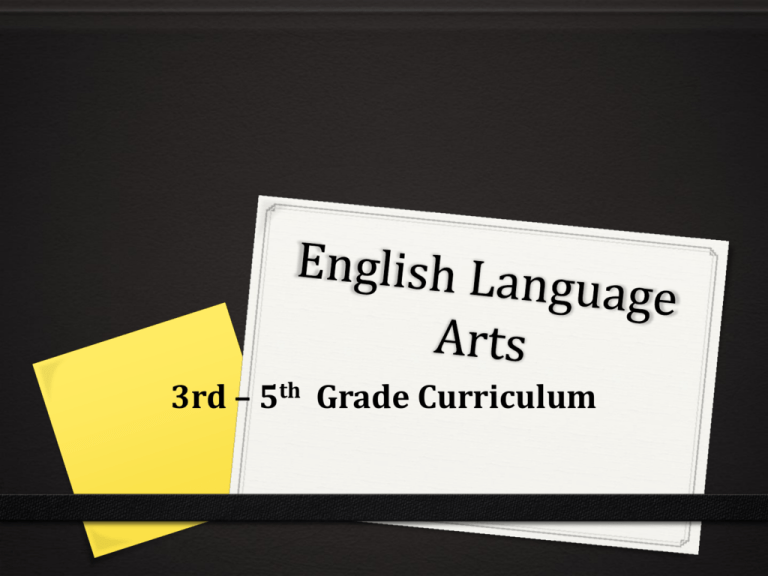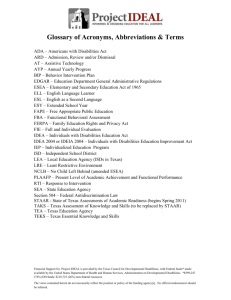
3rd – 5th Grade Curriculum
Classroom Instruction
0 CAFÉ Strategies:
0 Comprehension
0 Accuracy
0 Fluency
0 Expand Vocabulary
0 Guided reading:
0 Small group instruction based on reading level
0 Allows the teacher to address areas of concern
for each student
Istation
0 We provide time at school each week for
students to engage with Istation
0 Students should be logging into Istation at
home as well
0 Istation reinforces the major areas of
reading:
0 Comprehension
0 Vocabulary
0 Spelling/Word Analysis
0 Text Fluency
State Standards (TEKS)
0 Access all grade state standards (TEKS) from
the TEA website (link below)
0 http://www.tea.state.tx.us/curriculum/teks/
0 Scroll down on page to find TEKS by grade
level
0 Click on your student’s grade to view PDF
0 Lead 4 Ward is another excellent STAAR
informational website
0 http://www.lead4ward.com
Reporting Categories for
STAAR
0 Understanding and Analysis Across Genres
0 Includes: Vocabulary, Comprehension between two
pieces of texts from different genres
0 Understanding and Analysis of Literary Texts
0 Includes: Theme, Fiction, Poetry, & Drama
Comprehension, Sensory Language
0 Understanding and Analysis of Informational
Texts
0 Includes: Comprehension of Informational,
Procedural, & Expository texts
STAAR
0 STAAR exam includes fiction (may include
poetry and drama) and nonfiction texts
0 To be successful, students need to be able to:
0 Determine main idea & supporting details
0 Summarize
0 Make inferences (read between the lines)
0 Draw conclusions
0 Using textual evidence to support the answer
(underlining in passage where they got their
answers)
Nonfiction Passage—3rd Grade
Vaqueros: The Original Cowboys
1 Long before there were cowboys in Texas, there were
vaqueros. A vaquero could tame a wild horse. He could stop a
steer without using a rope. Vaqueros worked well with their
horses and could perform amazing stunts.
Caring for Cattle
2 At one time, Spanish ranchers in parts of Mexico, Texas, and
California owned huge herds of cattle. The cattle lived on large
areas of land. And all those cows needed a lot of food. The
animals were allowed to roam freely across the land so they
could find enough food to eat.
3 Caring for the cattle was a big job. Ranchers hired vaqueros
to keep the cattle safe. Vaqueros spent long days in their saddles,
riding their horses across the open land. They scared away any
animals that might harm the cattle. And if a cow was injured or
sick, it was the vaquero’s job to help it.
Selection taken from STAAR Grade 3 Reading 2011 Release Reading Selection 2
Copyright © 2011, Texas Education Agency. All rights reserved. Reproduction of all or portions of this work is prohibited without express written permission from the Texas
Education Agency.
Nonfiction Test Questions
What is the best summary of this article?
0 A Ranchers owned a lot of cattle. In order to find enough food, the cattle
had to roam freely across large areas of land. The ranchers needed help
with their cattle, so they hired vaqueros.
0 B Spanish ranchers hired vaqueros to take care of their cattle. The cattle
lived in large open areas. Vaqueros used horses and special clothing and
tools to help them with their work. When the ranchers moved away, the
vaqueros taught their skills to new settlers.
0 C Vaqueros took care of cattle that wandered across large areas of land.
The vaqueros watched over the cattle and chased harmful animals away.
They also helped find calves in springtime.
0 D Spanish ranchers owned cattle that grazed in large areas of grassland.
It was difficult to keep track of the cattle and take care of them. The
cattle ranchers needed some help, so they hired vaqueros, who were
similar to cowboys. Eventually the Spanish ranchers left.
From STAAR Grade 3 Reading 2011 Release
Copyright © 2011, Texas Education Agency. All rights reserved. Reproduction of all or portions of this work is prohibited without
express written permission from the Texas Education Agency.
Nonfiction Test Questions
Which sentence best supports the idea that horses were
helpful in controlling cattle?
0 A The animals were allowed to roam freely across the land
so they could find enough food to eat.
0 B Vaqueros spent long days in their saddles, riding their
horses across the open land.
0 C Getting cattle to move in one direction was not an easy
job.
0 D The horses were also trained to step in front of a cow that
was trying to escape from the herd.
From STAAR Grade 3 Reading 2011 Release
Copyright © 2011, Texas Education Agency. All rights reserved. Reproduction of all or portions of this work is prohibited without
express written permission from the Texas Education Agency.
Nonfiction Test Questions
The author includes headings in bold
print to —
0 A explain why the article was written
0 B describe why pictures were included in the article
0 C show which words are most important
0 D tell what information is in each section
From STAAR Grade 3 Reading 2011 Release
Copyright © 2011, Texas Education Agency. All rights reserved. Reproduction of all or portions of this work is
prohibited without express written permission from the Texas Education Agency.
Fiction: Poetry—4th Grade
To Manga, My Hamster
by Joyce Sidman
I wish I could set you free
like that day you escaped
and ran all over the house.
That was an amazing day.
5 My mother screamed.
My sister cried.
All because you were loose somewhere,
burrowing through pillows and toys.
When Mom finally found you
10 huddled in the mop bucket
(and you bit her)
you looked so fierce,
like your wild cousins
that roam the jungles of Asia.
15 I wish I had jungles to give you.
I wish that could be your life.
From STAAR Grade 4 Reading 2014 Release
Copyright © 2014, Texas Education Agency. All rights reserved. Reproduction of all or portions of this work is prohibited without express written permission from the
Texas Education Agency.
Poetry Test Question
What identifies this poem as an example of
free verse?
0 A Its lines are not similar in length.
0 B It does not follow a rhyming pattern.
0 C It uses figurative language to create imagery.
0 D It presents a lesson that can be learned.
From STAAR Grade 4 Reading 2014 Release
Copyright © 2014, Texas Education Agency. All rights reserved. Reproduction of all or portions of this work is prohibited without express
written permission from the Texas Education Agency.
Poetry Test Question
What is emphasized by the repetition of the
words “I wish” in the poem?
0 F The reason the speaker wants her mother to like Manga
0 G The speaker’s desire for Manga to have the best life
possible
0 H The length of time it takes the speaker to find Manga
when he escapes
0 J The speaker’s reason for keeping Manga as a pet
From STAAR Grade 4 Reading 2014 Release
Copyright © 2014, Texas Education Agency. All rights reserved. Reproduction of all or portions of this work is prohibited without express written permission
from the Texas Education Agency.
Poetry Test Question
Which line from the poem shows that the speaker is not
worried about Manga’s behavior upsetting her mother
and sister?
0 F That was an amazing day.
0 G My mother screamed.
0 H I wish that could be your life.
0 J Please forgive me.
From STAAR Grade 4 Reading 2014 Release
Copyright © 2014, Texas Education Agency. All rights reserved. Reproduction of all or portions of this work is prohibited without express written permission from the
Texas Education Agency.
Paired Selection—5th Grade
Stage Fright
by Lee Bennett Hopkins
I wanted the role.
The Prince.
The Prince.
I got it.
5 Knew it.
I was totally convinced.
I memorized each line.
Learned them by heart.
I studied and studied
10 my perfect Prince-part.
But—
when I took center stage
I stammered
stuttered
15 hemmed
hawed
suddenly shuddered.
From STAAR Grade 5 Reading 2013 Release
Copyright © 2013, Texas Education Agency. All rights reserved. Reproduction of all or portions of this work is prohibited without express written permission from the Texas
Education Agency.
Paired Selection—5th Grade
1 Imagine that you are an actor performing in a play for the first time. You have learned all
your lines, you know where to walk onstage, and your costume fits perfectly. Waiting behind
the closed curtain, you can hear people in the audience whispering and taking their seats. Then
your big moment arrives!
2 The curtain goes up, and the crowd falls silent. All you can see is the spotlight shining down
on you. You try to speak your lines, but nothing seems to come out. The inside of your mouth is
dry, and your palms are wet. The icy chill of panic starts to spread from your stomach to your
arms and legs.
3 If you have experienced a moment like this, you know all too well what it means to have
stage fright, also known as performance anxiety. It is one of the most common types of fear and
tends to strike people when they find themselves at the center of attention. You don’t have to
be onstage to get stage fright. People experience this fear when playing sports, giving a
business presentation, or even speaking in class. A person who suffers from stage fright may
get sweaty hands, a dry mouth, a tight throat, or shaky knees. Stage
fright is actually a form of panic, and these feelings are very real.
4 Stage fright is part of the body’s reaction to stress. The experience differs from person to
person, but the same chemical process occurs in each of us. In reaction to anxiety, our bodies
produce a chemical called adrenaline that prepares us to either fight or run away quickly.
Scientists refer to this as our bodies’ “fight or flight” reaction. As a result, we feel a boost of
energy that makes our palms sweat, our hearts race, and our knees shake.
From STAAR Grade 5 Reading 2013 Release
Copyright © 2013, Texas Education Agency. All rights reserved. Reproduction of all or portions of this work is prohibited without express written
permission from the Texas Education Agency.
Paired Selection Test Questions
Use “Stage Fright” to answer this question.
Read these lines from the poem.
I memorized each line.
Learned them by heart.
The poet uses the figurative expression “learned them by
heart” to emphasize that the speaker —
0 F has volunteered to be in the play
0 G practices on the stage
0 H enjoys playing the role of the prince
0 J feels prepared for his performance
From STAAR Grade 5 Reading 2013 Release
Copyright © 2013, Texas Education Agency. All rights reserved. Reproduction of all or portions of this work is prohibited without express written
permission from the Texas Education Agency.
Paired Selection Test Questions
Use “Fear Takes Center Stage” to answer this question.
The author speaks directly to the reader in
paragraphs 1 and 2 in order to —
0 F encourage the reader to try out for a play
0 G share a personal story with the reader
0 H help the reader understand the experience of stage
fright
0 J demonstrate that acting requires skill
From STAAR Grade 5 Reading 2013 Release
Copyright © 2013, Texas Education Agency. All rights reserved. Reproduction of all or portions of this work is prohibited
without express written permission from the Texas Education Agency.
Paired Selection Test Questions
Use “Stage Fright” and “Fear Takes Center Stage” to answer the question.
What is one difference between the selections?
0 F The article describes how stage fright feels, but the poem does not.
0 G The article provides a scientific explanation for stage fright, but the
poem does not.
0 H The poem indicates that a person can overcome stage fright, but the
article does not.
0 J The poem gives an example of a person with stage fright, but the article
does not.
From STAAR Grade 5 Reading 2013 Release
Copyright © 2013, Texas Education Agency. All rights reserved. Reproduction of all or portions of this work is prohibited without express
written permission from the Texas Education Agency.








